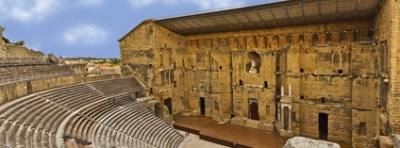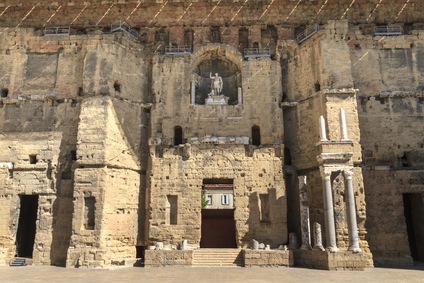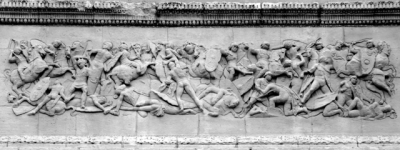The Roman Theater of Orange is a priceless legacy of Imperial Rome, and the (almost) perfect preservation of its stage wall is an exceptional testimony of antiquity. It is, to date, the best-preserved theater in Europe, a site intended at its creation to spread Roman culture. The nearly 10,000 spectators it could hold attended plays (comic or tragic) and entertainment (dance, acrobatics).
Théâtre Antique
Rue Madeleine Roch, 84100 Orange
Website - tel: 04 90 51 17 60.
Full price / reduced price: €9.50 / €7.50. Free for children under 7 years old. Entrance to the Musée d’Art et d’Histoire included.
Family package: €30.
Open every day:
November through February: 9:30 a.m. to 4:30 p.m. ;
March and October: 9:30 a.m. to 5:30 p.m. ;
April, May and September: 9 a.m. to 6 p.m. ;
June, July and August: 9 a.m. to 7 p.m.
Audio guide in 10 languages included with the ticket.
The official app "Antique Theater and Museum of Orange" is available for free on the Apple Store and Google Play.
At the fall of the Roman Empire, the theater lost its primary function. It became a defensive element of the city and it was invaded by houses. It was not until the 19th century, finally restored, that the theater found acclaim in welcoming performances. Today, it hosts a variety of summer events including the famous Choregies (see "Calendar of Events"). From the stands, the theater features a beautiful panorama of the city.
The Exterior Facade
At 103 meters long and 37 meters tall, the imposing exterior facade is divided into three levels. The first consists of three doors opening onto the stage and side doors opening onto the wings or other rooms. On the second level, the wall is devoid of any ornament. Framing and roofing tiles were attached to this level. A series of small arches adorns the third level. A large canvas was stretched across the top of the theater to protect the public in the event of rain or heat.
The Sun King
Upon seing the exterior facade of the Roman Theater, Louis XIV supposedly exclaimed "this is the finest wall in my kingdom."
The stage wall
The Roman Theater in Orange owes its fame to its magnificent stage wall, amazingly preserved and unique. It features 76 columns, multicolored marble plates, mosaics and many statues placed in decorated niches. Its outstanding acoustics are the result of well-placed niches and an overhang. The Royal Door, located at the center of the first level and reserved for main actors, was surmounted by a frieze decorated with a centaur, the remains of which are on display at the Musée d’Orange. The Royal Door was surrounded by niches decorated with statues.
The central niche houses the imperial statue of Augustus, 3.55 meters high (from the 1st century). Originally, this niche probably hosted a representation of Apollo, though it is likely that the triumphant emperor replaced the statue with one of himself, holding his baton of command. The side doors were used for the movement of the actors changing scenes. The second and third levels, composed of columns, are purely decorative.
To protect this unique work from environmental damage, the theater now features a 32-meter high glass roof.
The stage
The stage is framed by two towers, used for holding actors and stage devices before their entrance during performances. The upper floors were used as storage for decorations or accessories. At 61 meters wide and 13 meters deep, the stage had doors installed to bring out actors or machinery. Ingenious cables, winches and counterweights made it possible to hide the actors and the risers from the spectators.
The stands or cavea
Able to accommodate nearly 10,000 spectators, the stands were built into the hillside to facilitate their construction and durability. They were divided into three parts according to the social rank of the spectators. The upper classes took the lower places, with the most disadvantaged populations at the top.
The orchestra
At a diameter of 19 meters, this semi-circle in front of the stage is a legacy of Greek tradition: here stood the chorus of tragic plays.
Archaeological excavations have uncovered the foundations of a temple and the remains of a capitol building beside the theater.
The Ghosts of the Theatre
The show “Les Fantômes du Théatre” (The Ghosts of the Theatre) invites visitors on a fabulous journey through time. Characters that have graced the stage reappear through the magic of multimedia. The ghosts take you to the heart of great moments that have marked twenty centuries of history at the Roman Theater. The show takes place in four caves located behind the theater stands. This journey into the history of the Roman Theater allows younger visitors to understand the Roman history through science and fun. Possibility of a treasure hunt for more fun and learning (free for children 7 to 12 years old, available at the entrance).






